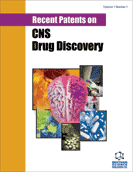Abstract
Multiple lines of evidence suggest that a dysfunction in the glutamatergic neurotransmission via the N-methyl- D-aspartate (NMDA) receptors contributes to the pathophysiology of psychiatric diseases including schizophrenia. The potentiation of NMDA receptor function may be a useful approach for the treatment of diseases associated with NMDA receptor hypofunction. One possible strategy is to increase synaptic levels of glycine by blocking the glycine transporter-1 (GlyT-1) in glia cells, since glycine acts as a co-agonist site on the NMDA receptor. In this article, the author reviews the recent important patents on GlyT-1 inhibitors for treatment of schizophrenia and other psychiatric diseases associated with the NMDA receptor hypofunction.
Keywords: NMDA receptor, glycine, glycine transporter, glia, cognition, schizophrenia
Recent Patents on CNS Drug Discovery (Discontinued)
Title: Glycine Transporter Inhibitors as Therapeutic Agents for Schizophrenia
Volume: 1 Issue: 1
Author(s): Kenji Hashimoto
Affiliation:
Keywords: NMDA receptor, glycine, glycine transporter, glia, cognition, schizophrenia
Abstract: Multiple lines of evidence suggest that a dysfunction in the glutamatergic neurotransmission via the N-methyl- D-aspartate (NMDA) receptors contributes to the pathophysiology of psychiatric diseases including schizophrenia. The potentiation of NMDA receptor function may be a useful approach for the treatment of diseases associated with NMDA receptor hypofunction. One possible strategy is to increase synaptic levels of glycine by blocking the glycine transporter-1 (GlyT-1) in glia cells, since glycine acts as a co-agonist site on the NMDA receptor. In this article, the author reviews the recent important patents on GlyT-1 inhibitors for treatment of schizophrenia and other psychiatric diseases associated with the NMDA receptor hypofunction.
Export Options
About this article
Cite this article as:
Hashimoto Kenji, Glycine Transporter Inhibitors as Therapeutic Agents for Schizophrenia, Recent Patents on CNS Drug Discovery (Discontinued) 2006; 1 (1) . https://dx.doi.org/10.2174/157488906775245336
| DOI https://dx.doi.org/10.2174/157488906775245336 |
Print ISSN 1574-8898 |
| Publisher Name Bentham Science Publisher |
Online ISSN 2212-3954 |
 22
22Related Articles
-
Aminophosphonate Metal Complexes of Biomedical Potential
Current Medicinal Chemistry Apoptosis Induction by Thalidomide: Critical for Limb Teratogenicity but Therapeutic Potential in Idiopathic Pulmonary Fibrosis?
Current Molecular Pharmacology Apathy Is not Associated with Performance in Brief Executive Tests in Patients with Mild Cognitive Impairment and Mild Alzheimers Disease
Current Alzheimer Research Functional Imaging as a Tool to Investigate the Relationship between Genetic Variation and Response to Treatment with Antipsychotics
Current Pharmaceutical Design Round and Round we Go: Cyclic Peptides in Disease
Current Medicinal Chemistry Pulmonary Vascular Function in Insulin Resistance and Diabetes
Current Vascular Pharmacology Presynaptic Cell Dependent Modulation of Inhibition in Cortical Regions
Current Neuropharmacology Bcl-2 Family Proteins as Therapeutic Targets
Current Pharmaceutical Design Immunomodulation Mechanism of Antidepressants: Interactions between Serotonin/Norepinephrine Balance and Th1/Th2 Balance
Current Neuropharmacology Target Recognition Molecules and Molecular Modeling Studies
Current Topics in Medicinal Chemistry Editorial [ Hot Topic:Endocannabinoid-Binding Receptors: Old Friends and New Comers (Guest Editor: Mauro Maccarrone)]
Current Medicinal Chemistry Preferential Formulation of Second Generation Antipsychotic Asenapine as Inclusion Complex with Sulphobutylether-βCD (Captisol): In vitro and In vivo Evaluation
Current Drug Delivery Neurotoxic Aβ: Linking Extracellular and Intracellular Aβ in Alzheimer’s Disease
Current Protein & Peptide Science Motor Complications in Parkinson’s Disease: A Comprehensive Review of Emergent Management Strategies
CNS & Neurological Disorders - Drug Targets The Role of FLT3 Kinase as an AML Therapy Target
Current Pharmaceutical Design Immunotherapy for Malignant Melanoma Robert
Current Stem Cell Research & Therapy A Pathological Brain Detection System based on Extreme Learning Machine Optimized by Bat Algorithm
CNS & Neurological Disorders - Drug Targets Thalidomide as an Immunotherapeutic Agent: The Effects on Neutrophil- Mediated Inflammation
Current Pharmaceutical Design Considering Autotaxin Inhibitors in Terms of 2D-QSAR and 3D-Mapping- Review and Evaluation
Current Medicinal Chemistry Chronotherapeutic Drug Delivery Systems - An Approach to Circadian Rhythms Diseases
Current Drug Delivery






















